Why you can trust Tom's Hardware
Test System Setup
For our CPU cooling tests, we use the same hardware, overclock and configuration for each and every test to minimize environment variables in testing. This allows for all results across all coolers tested on the platform to be viable as side-by-side examination for direct compare/contrast.
| CPU | Intel i9-10850k LGA1200 (Comet Lake), all 10 cores 4.6Ghz @ 1.190v (3.60Ghz stock speed, single core boost @ 5.2Ghz) |
| Motherboard | MSI Z490 MEG Godlike (bios vers. 7C70v12) |
| Memory | Corsair Dominator Platinum RGB, 16GB (2x8GB) DDR4-3600 |
| Graphics | Corsair MP600 M.2 2280 NVMe, 500GB |
| Power Supply | be quiet! Dark Power Pro11 1200w |
| Chassis | Corsair Graphite 760T |
| Monitoring | CrystalFontz CFA-633-TMI-KU, 4x Dallas One Wire WR-DOW-Y17 sensors |
| Fan Control | Corsair Commander Pro, 100%/50% PWM Speed profiles (liquid cooling pump always @100%, if applicable) |
| OS | Windows 10 Pro 64bit |
| Networking | Disconnected, not used |
| Thermal Compound | Arctic MX-4 |
Data comparisons are based on data collected from testing performed on our updated Intel i9-10850K system, including re-visiting many previously covered products which were originally covered on the prior testing platform which pivoted around an i7-5930k (4.20ghz @1.20v).
All data reported for this article has been collected on the current Intel i9-10850K platform and will be maintained as like-for-like evaluation of ongoing cooling coverage.
Prime95 v29.4b8 (no AVX) is used for two-hour intervals, one managing fans at 50% PWM and the other at 100% PWM with RPM measurements being taken every 3 seconds and averaged across the duration of each 2-hour capture. Omitting AVX instruction sets allows for accurate, 100% loads at chosen clock speeds, while allowing AVX instructions would provide higher, albeit, unrealistic synthetic CPU loads and excessive heat production, less indicative of real-world use.
This also allows for a greater range CPU coolers to be tested and compared without the need to configure the system differently for smaller coolers which may not handle the excessive thermal loads being generated during testing, while larger coolers might be better equipped to manage heat output produced by the i9-10850k.
While the test platform is quite capable of a 10-core overclock at 5.0Ghz and 1.265v, we were seeing 360mm AIOs struggle to keep core temperatures in check at lower fan speeds, providing insight that the enthusiast-grade i9s need excellent cooling if the goal is overclocking.
HWInfo64 is used for real-time core temperature readout, thermal throttling alerts, motherboard power consumption, CPU speed and logging of data, while a CrystalFontz CFA-633-TMI-KU is used to monitor and later average both ambient room (2 probes) and motherboard voltage regulator heatsink (2 probes)
Get Tom's Hardware's best news and in-depth reviews, straight to your inbox.
Comparison Coolers

The Aorus Liquid Cooler 360 maintains good company in regards to outright thermal performance at both 100% and 50% fan speeds. The slim margins between these large, 360mm AIOs shows us how close all of these coolers perform in CPU load test scenarios.
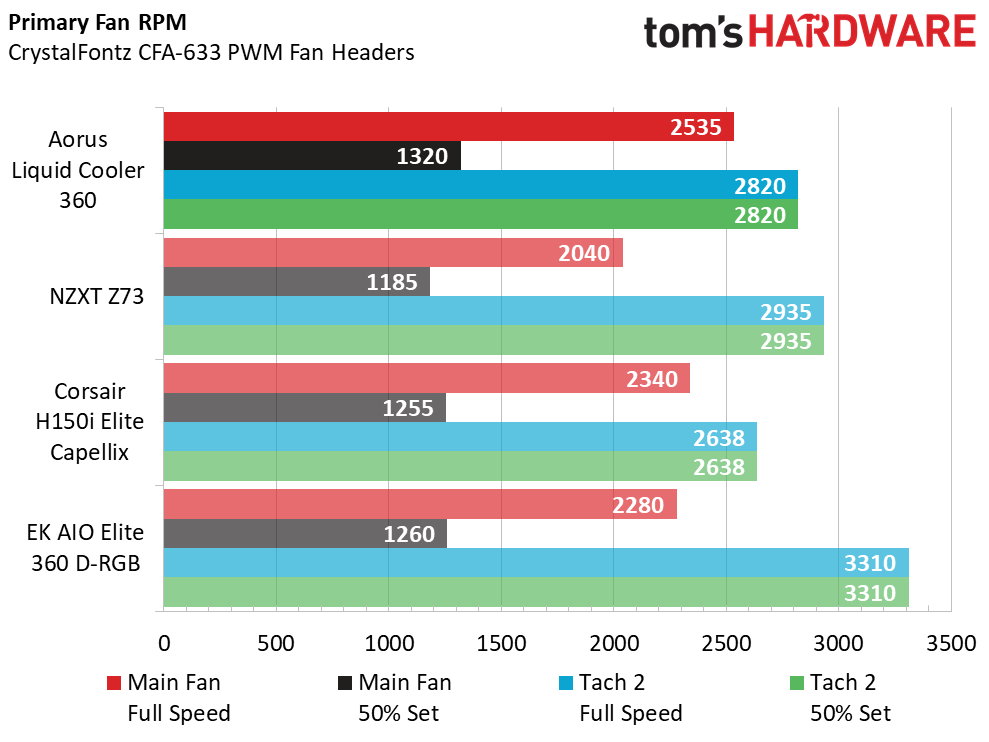
The Aorus 360 pushes the upper limits on outright fan RPM of the testing group, by reaching rotational speeds in excess of 2500 RRM.
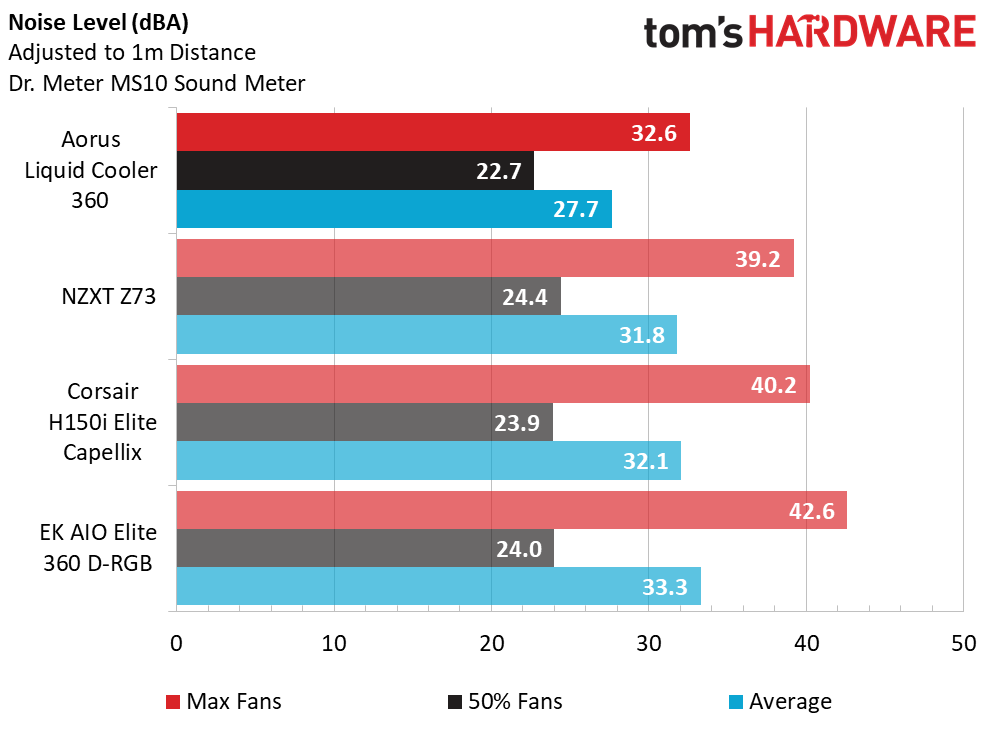
While it sports the fastest spinning fans, the Aorus Liquid Cooler 360 does not see the highest decibel rating by comparison. This can indicate a slight disadvantage of the fan profile by offering fast rotation speeds, but doing a bit less work at those speeds. By being relatively inefficient compared to other peers of the testing group, this gives the Aorus 360 a slight advantage in relative noise levels.
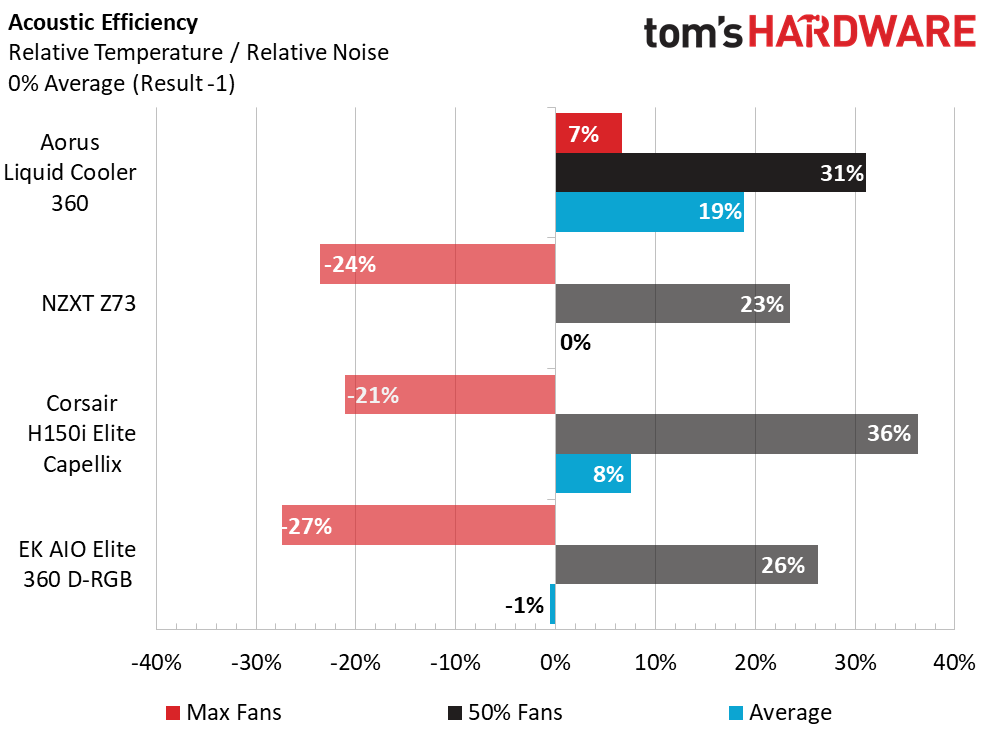
Acoustic efficiency evaluates cooler performance in thermal load trials with how well they function during operation. We see the Aorus 360 as the only cooler producing data among the testing group in which each result value is greater than zero.
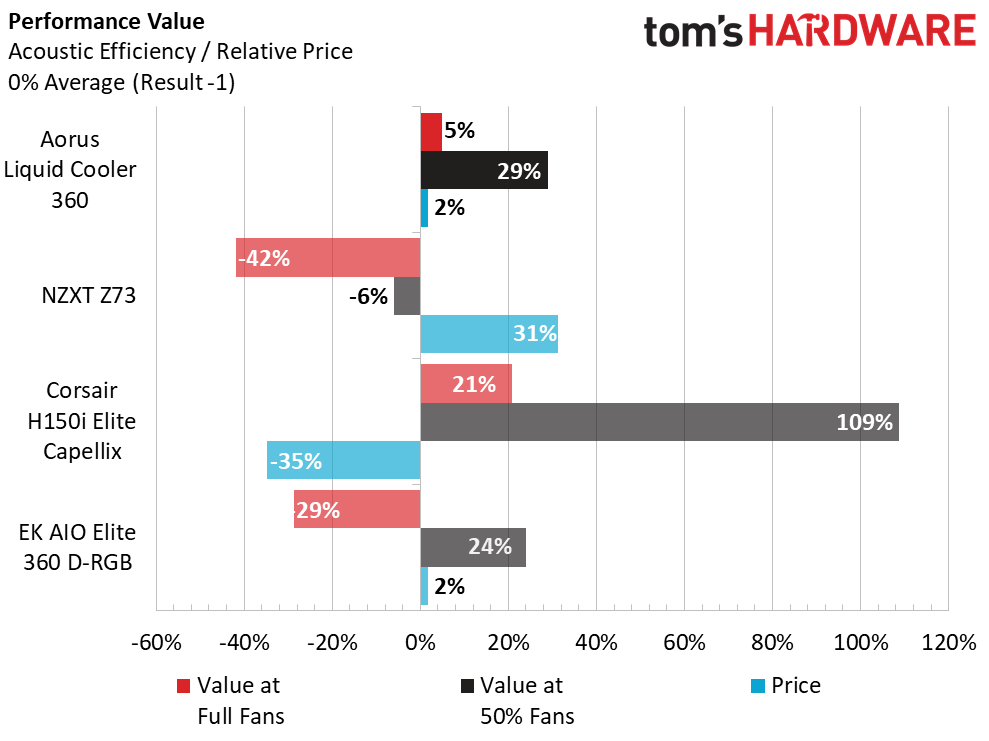
Overall cost of the Aorus Liquid Cooler 360 at $265 causes the overall value of the AIO to take a bit of a hit, but still manages to stay on the positive side of our performance value chart, while the much cheaper Corsair H150i Elite Capellix manages to surge ahead of the testing group. Large discrepancies in unit pricing can easily sway this result.
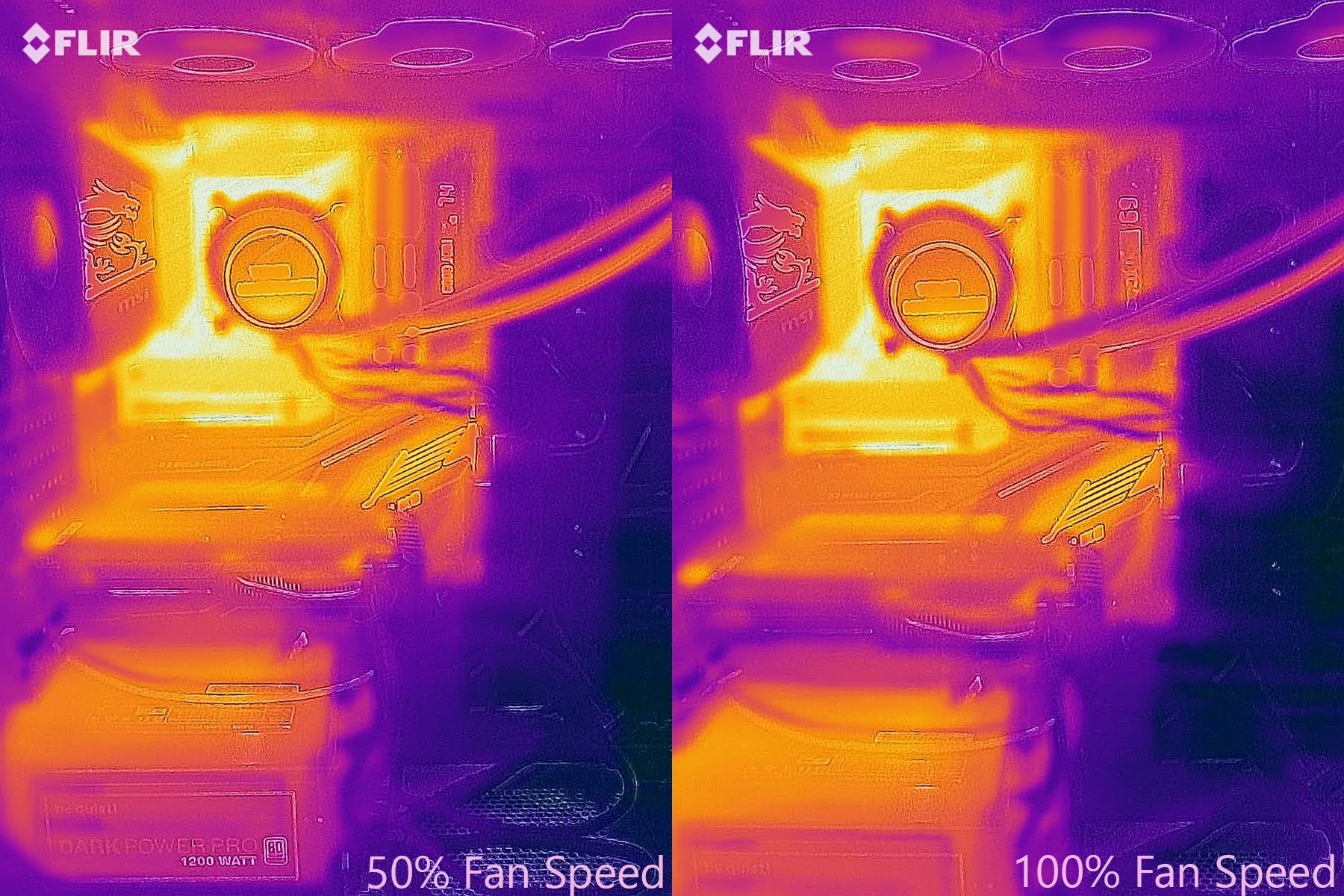
Thermal imaging from our FLIR ONE Pro camera provides a bit of an insight as to how the Aorus Liquid Cooler 360 operates under loads. We are able to see a bit more thermal soak at 50% fan speed, where lower fan RPM allows for more thermal energy to remain in the cooler under sustained loads, such as within the cooler’s tubing and around the pump housing itself. This also includes a noticeable difference of heat signature across the entirety of the 60mm LCD pump face.
The Aorus Liquid Cooler 360 does not necessarily provide the best thermal performance, nor is it one of the best-priced, but it does hold steady amidst a strong 360mm AIO market with a very handsome 60mm LCD face. With a bit of improvement and unified software UI, the Aorus 360 would easily overtake many of its peers, especially if it sees a price discount in coming months.

Garrett Carver is a contributor for Tom’s Hardware, primarily covering thermal compound comparisons and CPU cooling reviews; both air and liquid, including multiple variations of each.
-
Erik_1 ReplyAdmin said:The Aorus Liquid Cooler 360 delivers good cooling performance in a quiet package with a flashy customizable LCD screen atop the pump.
Aorus Liquid Cooler 360 Review : Read more
I owned the 240 version of this cooler, and the software was dangerous CPU melting garbage. It was so bad that six months later I'm still angry about it. On the plus side, the cooler is cold, quiet, and pretty. If you don't mind it being completely unreliable, please buy this brand.
So, what's the problem? The problem is the fan/pump speeds are entirely software/USB controlled, and, here's the bug: If the CPU got too busy (AMD Ryzen 7 2800) ... the software would freeze, and would require restarting the Aorus software via task manager. So, I start up say Vermintide, the screen on the CPU cooler shows 28 C. I'm thinking, wow, that's fantastic! OK, 10 minutes of playing later the fan speeds are flat, the pump speed is flat, display shows 28C. Well, it's all a lie. Go looking in AMD Ryzen master, actual temp is a lot hotter. WTF?
Restart Aorus, and bam, suddenly the pump and fans spin up, and the pump display temp jumps up 25 degrees. Finally used the MSI utility CPUID and it's CPU benchmark to prove the problem was as described. I could 100% reliably hang up the fan software.
So, into the garbage it goes. Then I switched to Thermaltake, who had been super reliable for me in the past. This one had a card fluttering (air bubble) sound no amount of tilting could get rid of. That goes into the garbage too and now, many hundreds of dollars wiser, I am using a custom loop with Argus Monitor and it's silent, quiet and 100% reliable.
I should point out this was not my only software problem with the Aorus kit, I had plenty of other instances of it hanging up trying to get a custom display, rotating the display etc. and same thing would happen, the fan and pump speeds would be locked in place until the software was forcibly restarted via task manager. -
Makinen I have an Aorus extreme GTX 1080ti (remember those?) and while I love the actual build quality of the hardware and the performance three years later, I absolutely agree with the Aorus software being useless rubbish. Luckily I would only use it for rgb and I just leave it at default these days, it would crash and hang and use up all my cpu all of the time. I would not buy an Aorus product again (or Gigabyte for that matter) as apparently they have not improved one bit...Reply